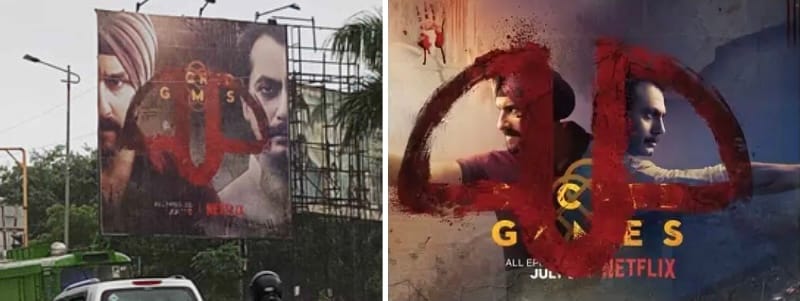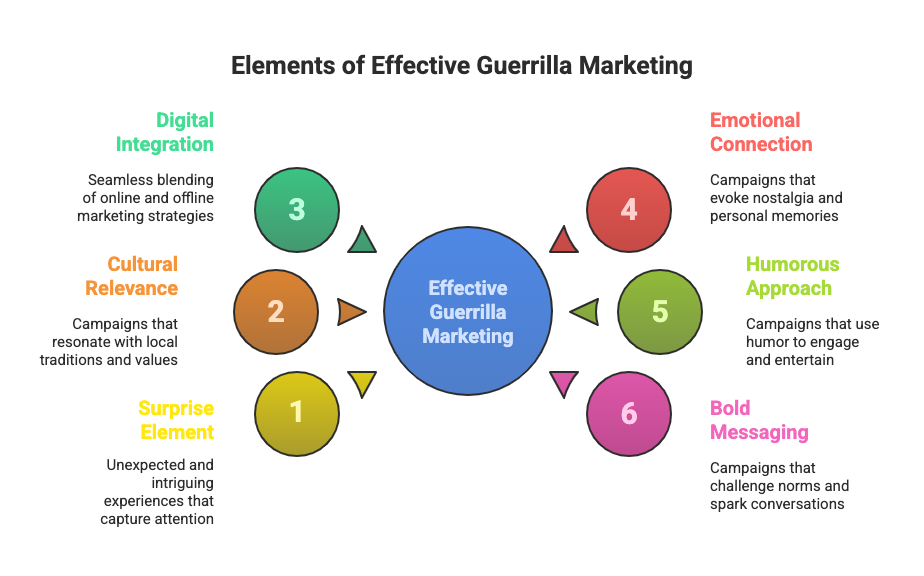10 Guerrilla Marketing Ads That Turned Heads in India
Guerrilla marketing isn’t just ads—it’s attitude. From Bitcoin kulhads to breakup trucks, these campaigns prove one thing: You don’t need a giant ad budget to make noise—you just need guts, smarts, and a bit of street flair.

Let’s Talk Guerrilla
Guerrilla marketing is more than just a buzzword—it’s a mindset. It’s marketing that moves in stealth, that shows up where you least expect it, and leaves a lasting impression where no billboard or ad slot ever could. In a country like India, where every corner, every street, and every tapri is buzzing with life, this style of marketing becomes even more powerful.
We’re not talking about cheap hacks or gimmicks. We’re talking about clever brand experiences that feel native to their setting and irresistible to the people around them. In 2025, Indian brands didn’t just embrace guerrilla—they owned it. Here’s a deep dive into 10 campaigns that truly brought the streets alive. If you're looking for top-notch examples of guerrilla marketing or even guerrilla advertising ideas that really clicked with the Indian audience, you're in the right place.

Looking for campaign inspo? Share this article with your team →
1. Swiggy Instamart x Godrej: #HomesDelivered
Where: Bengaluru (specifically Whitefield)
What: Godrej slipped miniature house keys into grocery bags delivered by Swiggy Instamart. Curious customers scanned QR codes leading to a microsite.
Why it worked: Surprise meets relevance. You order butter and find a house key—it’s unexpected, intriguing, and gets people talking.
Insider Insight: Leverage platforms that already deliver reliability. Swiggy’s existing trust made the Godrej campaign feel seamless.
Heads-Up: The real key? (Pun intended.) Tight backend coordination. Logistics and fulfilment have to be flawless.
This collaboration is one of those guerrilla marketing examples that seamlessly bridges offline surprise with online intent.
2. Netflix’s Sacred Games Billboard Reinvention
Where: Mumbai, key urban billboard zones
What: Netflix ingeniously repurposed old billboards used for their earlier show Sacred Games by pasting eerie symbols and blood-red visuals promoting Ghoul. The overlay created a spooky transition effect, linking two of their titles through shared lore and genre.
Why it worked: It was cost-effective, incredibly visual, and creatively reused existing media assets. People took notice not just of the campaign but of how smartly it tied into Netflix’s brand storytelling across multiple shows.
Pro Tip: Reinvent, don’t replace. A reused space with a new twist often catches more attention than something brand new.
Watch-Out: Reuse is great, but make sure the link between the old and new narrative is clear, or it risks confusion.
This billboard transformation stands as one of the most clever guerrilla advertising examples in India, using continuity, intrigue, and context to turn static media into interactive storytelling.

3. Durex: #ComeTogether Campaign
Where: Nationwide, digital and influencer channels
What: In 2019, Durex launched the bold #ComeTogether campaign, addressing the orgasm gap in India. Backed by research that nearly 70% of Indian women don’t orgasm during sex, the campaign challenged cultural silence and sparked necessary conversations. It promoted Durex Mutual Climax condoms designed to help partners climax together.
Why it worked: It wasn’t just a product push—it was a cultural conversation starter. The campaign blended influencer storytelling, hard-hitting facts, and witty digital content to get people talking where it matters: on social media and in relationships.
Veteran Move: Own a taboo. When you challenge the norms with authenticity and respect, your brand becomes more than a product—it becomes a voice.
Big Don’t: Don’t go bold just for shock value. This campaign worked because it was rooted in empathy, backed by data, and executed with class.
This campaign stands out as one of the most important guerrilla warfare marketing examples—turning education, emotion, and ethics into viral momentum.
4. Paper Boat’s “A Paper Boat Ride Down the River of Memories” Campaign
Where: Nationwide, digital-first with strong storytelling rollout
What: Paper Boat launched an animated film titled “A Paper Boat Ride Down the River of Memories,” narrated by Gulzar and accompanied by music that brought back memories of Malgudi Days. The film takes viewers on a nostalgic journey through childhood and festivals, tying emotions to each traditional drink they offer.
Why it worked: The campaign didn't just sell a product, it sold a feeling. By fusing visual storytelling with nostalgia and culture, Paper Boat carved a space in viewers' hearts, making its products more than beverages—they became time machines.
Quick Tip: Nostalgia is a powerful emotion. Use it to connect your brand with people's fondest memories, especially those rooted in food, festivals, and childhood.
Don’t Force It: Authenticity matters. This campaign worked because it stayed true to Paper Boat’s DNA of emotion, memory, and tradition.
Among guerrilla marketing ideas in India, this one stands out for turning storytelling into a digital activation that felt personal, emotional, and beautifully crafted.
5. CoinDCX's Bitcoin Chai Café
Where: Mumbai tech parks and local tea stalls
What: Tea was served in kulhads printed with quirky Bitcoin memes (Coin DCX themed obviously ;) and QR codes that led to bite-sized crypto explainers.
Why it clicked: Crypto can feel complicated. But combine it with the most democratic social ritual in India—chai—and you’ve got instant approachability. CoinDCX brought finance to the footpath.
Pro Tip: If your product feels alien, anchor it to a habit that’s deeply local and widely loved. It lowers the psychological barrier.
Check out the Bitcoin Chai Café Case Study in detail.
6. Volkswagen’s “Talking Newspaper”
Where: Major Indian cities via leading newspapers
What: Volkswagen took innovation to the breakfast table by embedding a voice chip inside the Times of India newspaper. As readers opened the page, they heard the sound of a roaring Volkswagen Vento engine, accompanied by a recorded message highlighting the car’s features.
Why it worked: It interrupted a daily ritual—reading the newspaper—with a sensory surprise. The juxtaposition of traditional print media and modern audio tech was unforgettable, driving home the car’s innovation-first identity.
Golden Rule: Disrupt routine experiences in unexpected ways. The more everyday the moment, the more powerful the disruption.
Insider Insight: Physical interactivity, like sound or motion in static media, creates memory hooks. This campaign had people replaying the page just to show others.
This stunt became one of India’s most talked-about guerrilla advertising examples and set a new benchmark for brand storytelling through unconventional media.
7. Blinkit x Tinder: Billboard Banter for Valentine's Day
Where: Urban hotspots in major Indian cities
What: Just in time for Valentine’s Day 2024, Blinkit and Tinder launched a witty billboard campaign that played out like a conversation. Tinder’s board cheekily asked, "You up?" and Blinkit’s billboard next to it shot back, "See you in 10."
Why it worked: It was timely, funny, and perfectly targeted at young, urban audiences who love playful, flirty brand humor. The juxtaposition of dating and delivery services made it instantly relatable—and very shareable.
Pro Tip: Co-branding works best when the tone, audience, and timing align. This campaign nailed all three.
Bonus Angle: Blinkit extended the campaign to its app with a ‘Singles Mode’—offering curated products for self-love and pampering.
This guerrilla campaign didn’t just grab eyeballs—it sparked conversations, screenshots, and laughs online and off.
8. Fevicol’s ‘Stuck Together’ Act at Kumbh Mela
Where: Kumbh Mela festival grounds, India
What: During the iconic Kumbh Mela, Fevicol deployed a group of people dressed in one T-shirt, making them appear literally 'stuck together'. Using the concept of human glue, the setup humorously visualized Fevicol’s long-standing tagline: "Fevicol ka mazboot jod hai, tootega nahi."
Why it worked: It plugged directly into a massive cultural moment with footfalls in the millions—where families often get separated in the crowd. Fevicol humorously claimed to 'keep them together' by dressing a group in a single branded T-shirt, visually representing strong bonds (pun very much intended).
Expert Advice: Cultural events offer rich storytelling potential. A clever tie-in can earn organic reach that even paid ads can’t match.
Important Note: When working in public spaces with heavy footfall, make sure installations are safe, interactive, and maintain crowd flow.
This campaign fused cultural relevance with visual humor—one of the best guerrilla marketing examples from India’s festival scene.
9. “Are Those Neeman’s Shoes?” Campaign
Where: Across Indian metros, high-footfall public spaces
What: Neeman’s launched a guerrilla campaign where micro-influencers shouted, “Are those Neeman’s shoes?” in public places—aiming not just to grab human attention, but to hack into the “always-listening” behavior of smartphones. The goal? Get phones to pick up the brand name and serve ads or searches on platforms like Instagram or Google.
Why it worked: It was bold, weird, and hard to ignore. By mixing curiosity, and a subtle conspiracy theory (your phone’s listening), it made people laugh—and more importantly, search.
Smart Hack: Leverage modern-day digital paranoia with a smile. When your campaign feels like a ‘glitch in the matrix,’ people talk.
Bonus Angle: Budget-friendly and scalable—Neeman’s used micro-influencers, not celebs, making the campaign feel more organic and guerrilla at its core.
This one isn’t just creative—it’s clever marketing psychology wrapped in a pair of eco-conscious shoes.
Among guerrilla advertising examples that offer real value, this one quenched thirst and curiosity alike.
10. Tinder’s Ex-press Disposal Truck
Where: Delhi and Mumbai, public roadsides and digital platforms
What: In early 2024, Tinder deployed a pink, oversized dump truck with the tagline “Emotional Baggage? We’ll help you dump it.” The truck was parked in visible spots where people could walk up and anonymously share emotional stories via QR codes, or simply snap photos with the quirky installation.
Why it worked: The visual metaphor was cheeky and instantly engaging. It combined humor, relatability, and Tinder’s core promise of moving on and starting fresh. A strong digital push helped scale the idea across reels and stories.
Expert Take: Emotional resonance + visual pun = scroll-stopping moment. Guerrilla activations that lean into shared experiences tend to spark deeper engagement.
Real Talk: Props and puns work best when tied directly to the brand’s mission. This one dumped the subtlety in the best way possible.
If you're looking for guerrilla advertising examples that win hearts while cracking smiles, this one delivers with flair.
What Makes Great Guerrilla Work... Work?

Bonus Tips from the Field:
- Keep it single-minded. Guerrilla fails when it tries to do too much.
- Define a clear trigger moment—a laugh, a jolt, a reveal. That’s the viral engine.
- Legal-proof it. Always check location permissions and public safety concerns.
- Measure what matters—footfall spikes, QR scans, social chatter—not just likes.
- Guerrilla isn’t a one-off. Plan a follow-through strategy: remarketing, email capture, or retargeted stories.
This guide isn’t just a recap—it’s your go-to collection of guerilla marketing examples that worked, why they did, and how to build your own.
To Conclude:
Guerrilla marketing is storytelling in 3D. It’s for brands that dare to be seen, heard, and remembered—in unexpected places and unforgettable ways.
At CupShup, this is our jam. We don't just craft campaigns—we create cultural moments that light up timelines and turn strangers into fans.
Let’s turn your next marketing moment into a street-level phenomenon.
Ready to break the internet with your next street-side stunt? Let’s talk.
[Let’s Cook Something Brave]
CupShup — The Innovation HQ for Modern Brands
For more innovative campaigns, check out other case studies & blogs .
"Want to understand the full strategy behind such campaigns? Check out our Experiential & Guerrilla Brand Activation Guide 2025."
